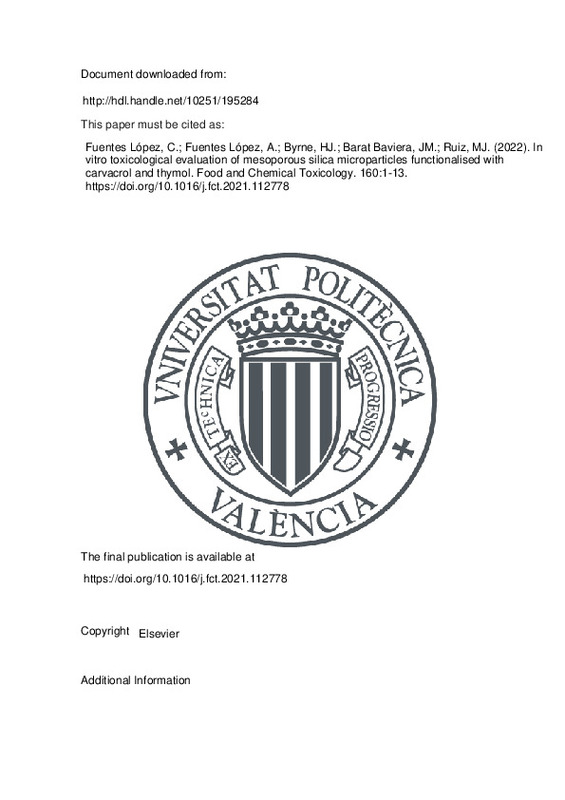JavaScript is disabled for your browser. Some features of this site may not work without it.
Buscar en RiuNet
Listar
Mi cuenta
Estadísticas
Ayuda RiuNet
Admin. UPV
In vitro toxicological evaluation of mesoporous silica microparticles functionalised with carvacrol and thymol
Mostrar el registro sencillo del ítem
Ficheros en el ítem
| dc.contributor.author | Fuentes López, Cristina
|
es_ES |
| dc.contributor.author | Fuentes López, Ana
|
es_ES |
| dc.contributor.author | Byrne, Hugh J.
|
es_ES |
| dc.contributor.author | Barat Baviera, José Manuel
|
es_ES |
| dc.contributor.author | Ruiz, María José
|
es_ES |
| dc.date.accessioned | 2023-07-20T18:01:40Z | |
| dc.date.available | 2023-07-20T18:01:40Z | |
| dc.date.issued | 2022-02 | es_ES |
| dc.identifier.issn | 0278-6915 | es_ES |
| dc.identifier.uri | http://hdl.handle.net/10251/195284 | |
| dc.description.abstract | [EN] The cytotoxicity of carvacrol- and thymol-functionalised mesoporous silica microparticles (MCM-41) was assessed in the human hepatocarcinoma cell line (HepG2). Cell viability, lactate dehydrogenase (LDH) activity, reactive oxygen species (ROS) production, mitochondrial membrane potential (Delta Psi m), lipid peroxidation (LPO) and apoptosis/necrosis analyses were used as endpoints. The results showed that both materials induced cytotoxicity in a time- and concentration-dependent manner, and were more cytotoxic than free essential oil components and bare MCM-41. This effect was caused by cell-particle interactions and not by degradation products released to the culture media, as demonstrated in the extract dilution assays. LDH release was a less sensitive endpoint than the MTT (thiazolyl blue tetrazolium bromide) assay, which suggests the impairment of the mitochondrial function as the primary cytotoxic mechanism. In vitro tests on specialised cell functions showed that exposure to sublethal concentrations of these materials did not induce ROS formation during 2 h of exposure, but produced LPO and Delta Psi m alterations in a concentration-dependent manner when cells were exposed for 24 h. The obtained results generally support the hypothesis that the carvacrol- and thymol-functionalised MCM-41 microparticles induced toxicity in HepG2 cells by an oxidative stress-related mechanism that resulted in apoptosis through the mitochondrial pathway. | es_ES |
| dc.description.sponsorship | The authors gratefully acknowledge the financial support from the Spanish government (Project RTI2018-101599-B-C21 (MCUI/AEI/FEDER, EU)). | es_ES |
| dc.language | Inglés | es_ES |
| dc.publisher | Elsevier | es_ES |
| dc.relation.ispartof | Food and Chemical Toxicology | es_ES |
| dc.rights | Reconocimiento - No comercial - Sin obra derivada (by-nc-nd) | es_ES |
| dc.subject | Mesoporous microparticles | es_ES |
| dc.subject | Silica | es_ES |
| dc.subject | Essential oil components | es_ES |
| dc.subject | Cytotoxicity | es_ES |
| dc.subject | HepG2 | es_ES |
| dc.subject.classification | TECNOLOGIA DE ALIMENTOS | es_ES |
| dc.title | In vitro toxicological evaluation of mesoporous silica microparticles functionalised with carvacrol and thymol | es_ES |
| dc.type | Artículo | es_ES |
| dc.identifier.doi | 10.1016/j.fct.2021.112778 | es_ES |
| dc.relation.projectID | info:eu-repo/grantAgreement/AEI/Plan Estatal de Investigación Científica y Técnica y de Innovación 2017-2020/RTI2018-101599-B-C21/ES/DESARROLLO Y APLICACION DE SISTEMAS ANTIMICROBIANOS PARA LA INDUSTRIA ALIMENTARIA BASADOS EN SUPERFICIES FUNCIONALIZADAS Y SISTEMAS DE LIBERACION CONTROLADA/ | es_ES |
| dc.rights.accessRights | Abierto | es_ES |
| dc.contributor.affiliation | Universitat Politècnica de València. Departamento de Tecnología de Alimentos - Departament de Tecnologia d'Aliments | es_ES |
| dc.contributor.affiliation | Universitat Politècnica de València. Escuela Técnica Superior de Ingeniería Agronómica y del Medio Natural - Escola Tècnica Superior d'Enginyeria Agronòmica i del Medi Natural | es_ES |
| dc.description.bibliographicCitation | Fuentes López, C.; Fuentes López, A.; Byrne, HJ.; Barat Baviera, JM.; Ruiz, MJ. (2022). In vitro toxicological evaluation of mesoporous silica microparticles functionalised with carvacrol and thymol. Food and Chemical Toxicology. 160:1-13. https://doi.org/10.1016/j.fct.2021.112778 | es_ES |
| dc.description.accrualMethod | S | es_ES |
| dc.relation.publisherversion | https://doi.org/10.1016/j.fct.2021.112778 | es_ES |
| dc.description.upvformatpinicio | 1 | es_ES |
| dc.description.upvformatpfin | 13 | es_ES |
| dc.type.version | info:eu-repo/semantics/publishedVersion | es_ES |
| dc.description.volume | 160 | es_ES |
| dc.identifier.pmid | 34958804 | es_ES |
| dc.relation.pasarela | S\452588 | es_ES |
| dc.contributor.funder | AGENCIA ESTATAL DE INVESTIGACION | es_ES |
| dc.contributor.funder | European Regional Development Fund | es_ES |







![[Cerrado]](/themes/UPV/images/candado.png)

